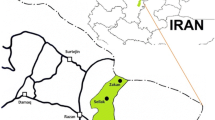Abstract
Rodents are mammals of the order Rodentia and can harbor a number of ectoparasites. Ectoparasites can transmit diseases to human and domestic animals in residential and non-residential areas. The aim of this study was to determine the prevalence of ectoparasites in Rattus rattus from Mangrove forests and villages of Qeshm Island. The rodent samples were collected by live traps during 2013–2014. The gender, genus, and species of captured animals were recorded and ectoparasites were collected by skin surface brushing, and subsequently, samples were identified in a laboratory. Overall, 100 rodents were captured in the present study and three species of ectoparasites were collected as follows: Polyplax spinulosa (66%), Laelaps nuttalli (61%), and Liponyssoides muris (10%). Generally, 80 rodents (80%) were infested with at least one species of ectoparasites. Statistical analysis by the chi-square test did not show any significant relation between gender and ectoparasites (p ˃ 0.05). The results of our study indicate that high infestation of the ectoparasite community associated with the rodents captured from Mangrove forests and villages of Qeshm Island is important in terms of public health.


Similar content being viewed by others
References
Ahamad M, Ibrahim H, Bujang MK, Sah SAM, Mohamad N, Nor SM, Ahmad AH, Ho TM (2013) A survey of acarine ectoparasites of bats (Chiroptera) in Malaysia. J Med Entomol 50:140–146
Allymehr M, Tavassoli M, Manoochehri MH, Ardavan D (2012) Ectoparasites and gastrointestinal helminths of house mice (Mus musculus) from poultry houses in Northwest Iran. Comp Parasitol 79:283–287
Aplin KP, Suzuki H, Chinen AA, Chesser RT, Ten Have J, Donnellan SC, Austin J, Frost A, Gonzalez JP, Herbreteau V, Catzeflis F (2011) Multiple geographic origins of commensalism and complex dispersal history of black rats. PLoS One 6:e26357
Azad AF (1986) Mites of public health importance and their control. World Health Organization, Geneva
Baker AS (1999) Mites and ticks of domestic animals: an identification guide and information source. The Stationary Office, London
Bowman DD (2014) Georgis’ parasitology for Veterinarians-E-Book. Elsevier Health Sciences, Amsterdam
Durden LA (1988) The spiny rat louse, Polyplax spinulosa, as a parasite of the rice rat, Oryzomys palustris, in North America. J Parasitol 74:900–901
Etemad A (1978) Mammals of Iran, rodents and identification key, Tehran, Natural Resource Protection and Human Environment Association Press. [In persian]
Ferris GF (1951) The suking lice. Vol 1. The Pacific coast Entomological Society Publication
Garcia LS (2007) Diagnostic Medical Parasitology, 5th ed, American Society Microbiology Press, Washington, DC
Gilioli R (2003) Avaliação do perfil sanitário de colônias de camundongos e de ratos em biotérios brasileiros: ocorrência de bactérias, parasitas e vírus murinos. Campinas, 2003. Tese (Doutorado em Genética e Biologia Molecular). Instituto de Biologia da Universidade Estadual de Campinas.[In Portuguese]
Hirst S (1913) On three new species of gamasid mites found on rats. Bull Entomol Res 4:119–124
Kay EH, Hoekstra HE (2008) Rodents. Curr Biol 18:406–410
Kia EB, Moghddas-Sani H, Hassanpoor H, Vatandoost H, Zahabiun F, Akhavan AA, Hanafi-Bojd AA, Telmadarraiy Z (2009) Ectoparasites of rodents captured in Bandar Abbas, Southern Iran. J Arthropod Borne Dis 3:44–49
Loehle C (1995) Social barriers to pathogen transmission in wild animal populations. Ecology 76:326–335
Marshall AG (1976) Host-specificity amongst arthropods ectoparasitic upon mammals and birds in the New Hebrides. Ecol Entomol 1:189–199
Montasser AAM (2013) Redescription of female Laelaps nuttalli Hirst, 1915 (Acari: Dermanyssoidea: Laelapidae) with emphasis on its Gnathosoma, sense organs and pulvilli. ISRN Parasitol 2013:1–8. https://doi.org/10.5402/2013/642350
Nateghpour M, Akhavan AA, Hanafi-Bojd AA, Telmadarraiy Z, Ayazian Mavi S, Hosseini-Vasoukolaei N, Motevalli-Haghi A, Akbarzadeh K (2013) Wild rodents and their ectoparasites in Baluchistan area, southeast of Iran. Trop Biomed 30:72–77
Pimentel D, Zuniga R, Morrison D (2005) Update on the environmental and economic costs associated with alien-invasive species in the United States. Ecol Econ 52:273–288
Rahdar M, Vazirianzadeh B, Rointan ES, Amraei K (2015) Identification of collected ectoparasites of rodents in the west of Khuzestan Province (Ahvaz and Hovizeh), southwest of Iran. Asian Pac J Trop Dis 5:627–631
Yousefi A, Chaechi-Nosrati MR, Karimi A, Naisi S (2015) Leptopsylla taschenbergi taschenbergi (Siphonaptera: Leptopsyllidae), new flea from Iran. Asian Pac J Trop Dis 5:930–931
Yousefi A, Ghorbani MN, Salehi-Guilandeh S (2016) Leptopsylla algira costai (Siphonaptera: Leptopsyllidae): new host and new geographical record. J Coast Life Med 4:953–954
Yousefi A, Eslami A, Rahbari S, Mobedi I (2017) Parasitic infections of bicoloured white-toothed shrew (Crocidura leucodon) from Dasht-e-Razan, Western Iran. Iran J Parasitol 12:123–129
Yousefi A, Rahbari S, Eslami A (2018) Ectoparasites associated with small mammals (orders Insectivora, Eulipotyphla, and Rodentia) in Razan plain, western region of Iran. Comp Clin Pathol 27:667–671
Zendehfili H, Zahirnia AH, Maghsood AH, Khanjani M, Fallah M (2015) Ectoparasites of rodents captured in Hamedan, Western Iran. J Arthropod Borne Dis 9:267–273
Acknowledgements
The authors would like to thank Ms. Tahreh Ghadirian and Ms. Mona Hamzehpur for helping us in collecting the samples.
Funding
This study was funded by the Science and Research Branch of Islamic Azad University, Tehran.
Author information
Authors and Affiliations
Corresponding author
Ethics declarations
Ethical approval
All applicable international, national, and/or institutional guidelines for the care and use of animals were followed.
Conflict of interest
The authors declare that they have no conflict of interest.
Rights and permissions
About this article
Cite this article
Eslami, A., Yousefi, A. & Dowling, A.P.G. Prevalence of ectoparasites in black rat (Rattus rattus) from Mangrove forests of Qeshm Island, Iran. Comp Clin Pathol 27, 1583–1586 (2018). https://doi.org/10.1007/s00580-018-2777-3
Received:
Accepted:
Published:
Issue Date:
DOI: https://doi.org/10.1007/s00580-018-2777-3




